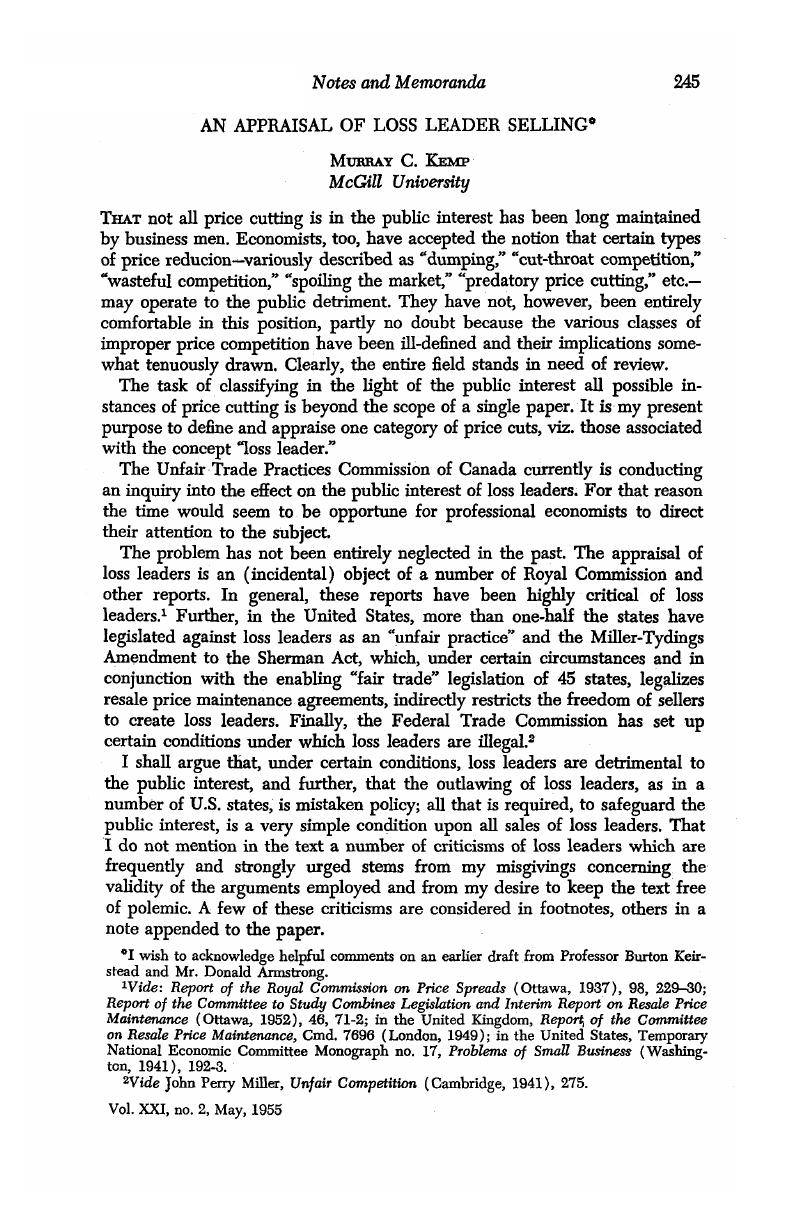Article contents
An Appraisal of Loss Leader Selling*
Published online by Cambridge University Press: 07 November 2014
Abstract

- Type
- Notes and Memoranda
- Information
- Canadian Journal of Economics and Political Science/Revue canadienne de economiques et science politique , Volume 21 , Issue 2 , May 1955 , pp. 245 - 250
- Copyright
- Copyright © Canadian Political Science Association 1955
Footnotes
I wish to acknowledge helpful comments on an earlier draft from Professor Burton Keirstead and Mr. Donald Armstrong.
References
1 Vide: Report of the Royal Commission on Price Spreads (Ottawa, 1937), 98, 229–30Google Scholar; Report of the Committee to Study Combines Legislation and Interim Report on Resale Price Maintenance (Ottawa, 1952), 46, 71–2Google Scholar; in the United Kingdom, Report, of the Committee on Resale Price Maintenance, Cmd. 7696 (London, 1949)Google Scholar; in the United States, Temporary National Economic Committee Monograph no. 17, Problems of Small Business (Washington, 1941), 192–3.Google Scholar
2 Vide Miller, John Perry, Unfair Competition (Cambridge, 1941), 275.CrossRefGoogle Scholar
3 Report of the Royal Commission on Price Spreads, 228. A similar definition is provided in United Kingdom, Report of the Committee on Resale Price Maintenance, 9. See also Weintraub, S., Price Theory (New York, 1949), 326.Google Scholar
4 “Replacement cost” is not an unambiguous concept. However, further refinement is not essential to our central purpose.
5 This has been proved, for the special case of linear demand and cost functions, by Roos, C. F. in his Dynamic Economics (Bloomington, Ill., 1934), chap. VIII.Google Scholar
Of course, if a firm offers to sell, below cost, unlimited quantities to all comers, its competitors will find it to their advantage to buy from it and resell to the public at the same price, thus saddling the price cutter with a huge loss. But this fate can be avoided by discriminatory pricing or by setting a maximum to the purchases per unit of time by any single individual or firm.
6 In the Report of the Royal Commission on Trice Spreads, bread and certain cuts of meat are listed as commodities which have served in Canada as loss leaders (pp. 58, 98). Cigarettes and sugar also appear to have served frequently in this capacity.
7 Weintraub has argued that a commodity can be a successful loss leader only if it has an inelastic demand, “… otherwise the direct losses are likely to outweigh the indirect complementary gains” (Price Theory, 326). In this passage he appears to overlook the fact that an inelastic demand for A is inconsistent with the power of a cut in the price of A to attract new customers. Weintraub goes on to say: “Frequently, purchases of loss leaders will be rationed as to the quantity purchased at the submerged price. This serves implicitly to cut the demand elasticity and limits the direct losses suffered by the seller while still evoking complementary buying of other commodities.” (Ibid., 326–7.) Such a statement presupposes incredible naivete on the part of buyers.
8 It is claimed, sometimes, that not only do loss leaders result in the distortion of relative prices within the group of commodities sold by the multi-product retailer, but that the general level of prices within that group is raised relative to all other prices. The concentration of retailing in the hands of a few multi-product firms is alleged to imply a reduction of competition, a restriction of output and a general increase in the prices of those commodities sold by the multi-product stores. Now there is little doubt that the number of retail outlets will decline, or grow less rapidly than otherwise, as the result of the employment of loss leaders. But a decline in the number of outlets does not imply a weakening of price competition. For a dcline in the total number of sellers does not imply a similar decline in the number of sellers of any particular product.
9 Vide Report of the Royal Commission on Price Spreads, 229–30. Most of the U.S. state legislation contains escape clauses to cover loss leaders of these types.
10 This statement is, I believe, borne out by the experience of the U.S. states in which the legislation has been almost a dead letter. See previous footnote.
11 Report of the Royal Commission on Price Spreads, 229.
12 Ibid., 228-9.
13 Ibid.
- 5
- Cited by




